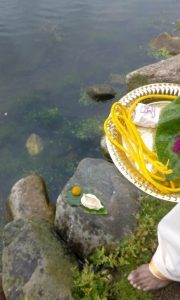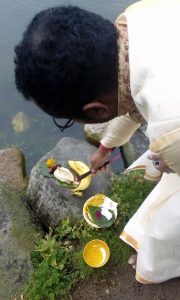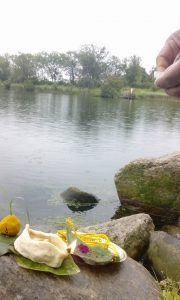So here I am, married to my Tamilian superman, eager to learn everything about the South Indian Culture. Yes, you guessed it right, I am not a Tamilian girl and I am now discovering the language, rituals, traditions and everything that comes with it.
Since I got married (which is not very far down memory lane, been only a month), I have been learning here and there bits of pieces of this rich Dravidian culture. However, we have been talking about Aadi a lot at home in L’Escalier, Mauritius. Selven and I were quite sad about the fact that we were going to celebrate Aadi away from our parents. Most of the things I have learnt about this festival come from conversations that I have had with my father in law, Aya Seeven, my brother in law Poulaven and My Husband Pirabarlen (Selven).
So what is Aadi Padinettam Perukku?
Adiperukku is a Tamil festival celebrated on the 18th day of the Tamil month of Adi (July to August). The festival is predominantly observed by South Indian women.
Padinettam perukku coincides with the period where basins of Tamil Nadu and major lakes’ water level rise due to the monsoon. As mentioned by my father in law, Padinettam means 18, normally long ago, people used to keep track of dates depending on the marches they had in open baths in India. They celebrated the rise in water level during the monsoon season. The festival is celebrated when the water level reaches the 18th step of the open baths and this coincides with the 18th day of the solar month of Aadi corresponding to the 2nd or 3rd August every year. Hence “Padinettam perukku” – Padinettu signifies eighteen and Peruku denotes rise.
There are several schools of thought onto why this festival is celebrated.
First of all, the festival pays tribute to the life giving/sustaining properties of water. It is celebrated when all the rivers and lakes are bountiful with fresh water.
In India the rivers like Ganges and Yamuna and Cauvery are considered sacred. Civilizations, not only in India where built across rivers and lakes and seas. People began worshiping water sources and there are also beliefs that water sources are other forms of deities, reason why temples normally have wells or other type of natural water sources that are considered sacred.
This ritual is also associated with the renewal of the love; 2 people forming a couple have for one another. As mentioned by Poulaven during a conversation, the couple’s wish is to renew their love by imploring the deities to make the love, the couple holds, to the image of the vastness of the oceans. The string holding the Taali is therefore released in the ocean or a river which finishes its course in the sea. However, in cases where there are no rivers, lakes or other natural water sources around, it is even allowed to use a tap as a water source to perform the ritual. One has to live with his/her times we would say!
In ancient times, this water ritual practice was performed on the banks of Rivers, which is described as a rice-cultivation tract. Aadi is the month for sowing, planting of seeds and vegetation since it is peak monsoon time when rain is showered in abundance. People living off rice cultivations, would offer prayers to the water goddess to ensure of a good yield for harvest during the Thai Pongal Festival which is celebrated five months after the months of aadi, I.e, in January (Thai) every year.
Another thing that the month of Aadi is, is that, this particular month of the Tamil Lunar Calendar is a greatly inauspicious month to start major/ important tasks in one’s life or career. For example there are no weddings that are celebrated during the month of Aadi, another reason why Aadi is a month of fervor for Hindus where poosei/pujas/prayers are offered to seek the protections of the gods.
So, let’s talk about how my first Aadi with my husband went by or rather let’s have a glimpse of Aadi in Copenhagen, Denmark.



